A Guide to Content Syndication [Definition, Strategy & More]
What is the best way to drive more attention to your content?
We’ve covered four strategies in our content marketing guide, one of which is doing PR and content syndication, in particular. However, we didn’t go into much detail on what this tactic entails and how to use it correctly.
But today is the day! Let us introduce you closer to content syndication and show how your brand’s online presence can benefit from it in the long run.
Let’s dive in!
What is Content Syndication?
Content syndication is a strategy that involves republishing a piece of content on one or more online resources. It’s a win-win way both for the content’s owner and the publisher: the latter gets to share a fresh piece of information with their audience, while the author has an opportunity to reach a new audience.
Is content syndication similar to guest blogging?
No, not really. Although both have the same goal of expanding reach and boosting engagement, you create entirely new content for a guest post, while syndication involves republishing already existing content or its synopsis on a specific platform with your permission.
By the way, content syndication is an outbound lead generation and demand generation practice. We’ve covered it briefly along with other strategies in our article, make sure to check it out.
Now, let’s discuss the three common types of content syndication.
3 Types of Content Syndication
We can divide content syndication into three main forms – free, paid, and owned. Here’s a handy graph showing these categories and their main characteristics:
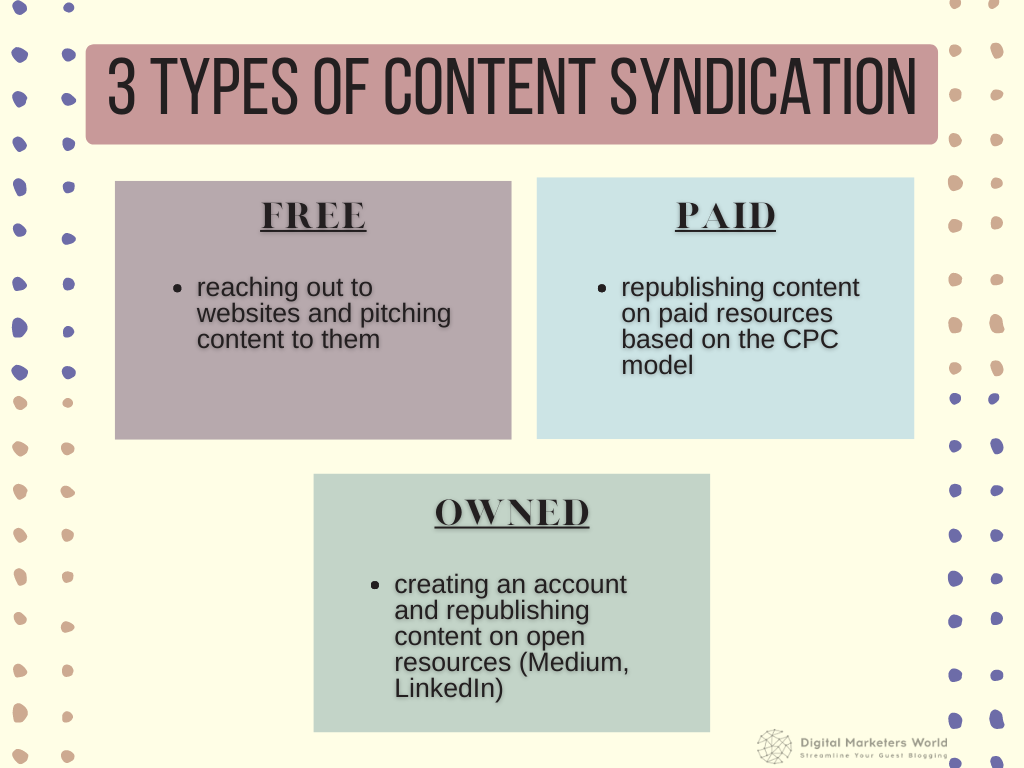
Let’s take a closer look at these content syndication types in more detail and discuss some use cases.
1. Free syndication
With free content syndication, you should first select the content to promote and then reach out to particular websites and pitch content to them. This type implies building partnerships with bloggers, podcast hosts, website owners, etc., which can take some time, but is more beneficial in terms of SEO than any other form of syndication.
Here are some ways to syndicate your content for free:
- Republish content on bigger websites. Look for online resources with more authority and a larger readership to get more brand awareness. That’s right – with this strategy, you shouldn’t expect many people to visit your site since they can check out your content piece in full on the website where it’s syndicated. However, it’s still a valid way to increase online presence.
- Syndicate on online platforms with the same audience. This method works well if you don’t want to expand your reach outside your niche audience. You can also add more internal links to the syndicated content to drive more people to your website.
If your content is super original and delivers immense value to people (such as case studies, research, infographics, charts, and so on), you might see some resources pick up, republish it, and link back to your own website over time. However, watch out for poor-quality websites linking back to you – such links do more harm than good.
2. Paid syndication
Paid syndication means republishing your content on paid resources. It is somewhat similar to an online ad in that it helps you reach a new audience in exchange for a fee.
By the way, the algorithm that online publishers follow with paid syndication resembles PPC. When setting up your content syndication campaign, you also need to establish the budget, a target audience, and the cost per click.
Here’s how it works: the readers see the title of your content, an image, and a link to your website. Each time they click on the link, you get charged for it, and the cost depends on your target audience and some other factors.
Note, however, that links to your website obtained through paid syndication don’t carry any SEO value, nor do they bring any organic traffic. Yet, they work fantastic if you want more brand awareness. So, if it’s your goal, go for it!
3. Owned syndication
Owned syndication resembles the free type in some ways, but you don’t have to contact anyone to make this strategy work – you use the resources available to you.
Here’s the trick – there are some online websites that can host your content for free upon subscribing, such as Linkedin and Medium. You can syndicate your content there and add the Originally published on [name of the website] remark at the top to get people to check out the initial source as well:
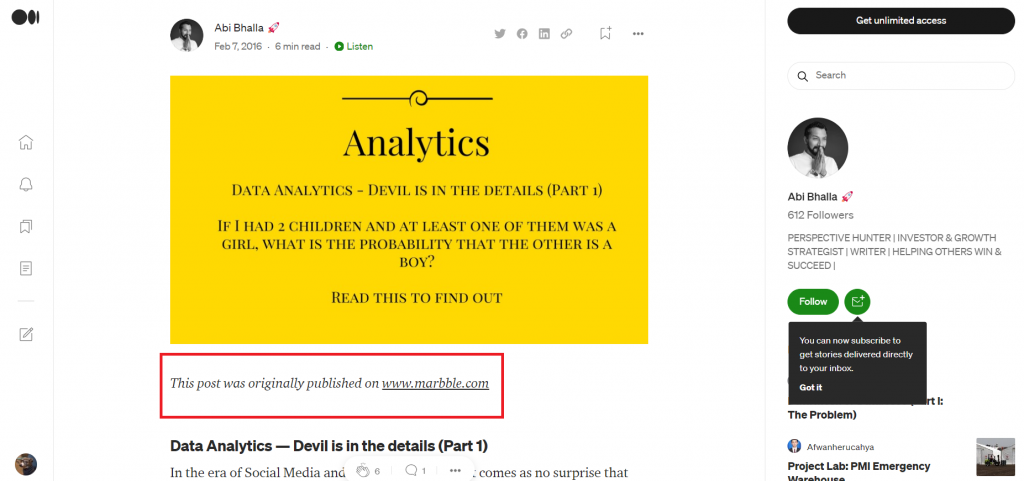
The same goes for LinkedIn – you can write original articles or publish existing content there. Besides, it’s a social media platform with immense reach among B2B audiences, so this is a great opportunity to reach some decision-makers in your industry.
With the types clear, let’s go over the main content syndication benefits.
5 Benefits of Content Syndication
Even though syndicating content is an outbound strategy, and it’s not as widespread as most inbound lead generation tactics, it still has quite a few significant perks that could give a boost to your marketing efforts.
Let’s see what these perks are.
Benefit #1: Increases brand awareness
The first and the most significant benefit of content syndication marketing is spreading the word about your brand. As you promote content on various platforms, their readerships get exposed to it and introduced to your company and product.
With a content syndication strategy, you also grow your brand’s credibility and authority since it allows you to republish content on niche websites with audiences similar to yours. Apart from that, employing this outbound marketing tactic grows your presence in the industry as a thought leader and educational guru, ultimately boosting brand recognition as well.
Benefit #2: Drives traffic to your website
If you’re looking for another opportunity to drive organic traffic outside of doing search engine optimization of your website, you can try free and owned content syndication types. As we mentioned, backlinks from free and owned resources can drive a great deal of traffic and boost your website’s authority.
Also, while we’re on the topic of SEO, we encourage you to include other internal links in your syndicated content. Why? When the piece gets published on various credible resources, it will pass authority through these internal links, creating signals for Google that this content brings high value and thus, deserves attention.
Benefit #3: Generates backlinks
This benefit stems from the previous one. When a resource publishes your content in full or uploads a synopsis or excerpt of it, you get a link back to your website. Besides, as we mentioned earlier, unique content can generate backlinks over time as it gets shared by other websites that find it interesting.
So, it’s fair to say that content syndication can help you build your backlink profile. Besides, if most of these backlinks come from websites with higher domain authority than yours, it will grow your website authority as well.
However, using content syndication for link building and SEO can also have some risks. We’ll talk about them a bit later.
Benefit #4: Provides access to a broader audience
Online resources that partake in content syndication usually have a bigger traffic pool and large audiences, so making a publication there can expose your brand to more people.
So, if you want more leads from a similar industry or are looking into introducing your business to different markets, make sure to weave content syndication into your marketing strategy. However, when you republish content on large websites, it also means that they make posts on a variety of topics, and there’s a chance your article or research will appear in front of a completely irrelevant audience. So, we recommend going for more niche websites first and growing your reach gradually.
Benefit #5: Generates leads
Finally, as you already know, content syndication is a solid lead generation strategy. In fact, 30% of B2B marketers consider this strategy the most effective in acquiring more prospects.
Indeed, you can get more new customers through syndicating great content, especially if its value resonates with them. For instance, if you republish your eBook, toolkit, templates, or webinar announcement, people who find it interesting will share the name and email with you via a contact form, effectively growing your lead list.
Now, of course, content syndication has its cons, so let’s review them next to help you form the complete picture of this strategy.
3 Disadvantages of Syndicated Content
As with any digital marketing strategy, content syndication is not perfect either. You will need to distribute really high-quality content to raise the chances of getting noticed, and creating relevant content takes a lot of time and resources. But unfortunately, even that can’t guarantee that it will get the attention it deserves.
Let’s talk about some other disadvantages you need to keep in mind when considering syndicating your content.
Disadvantage #1: May attract low-quality leads
Not every acquired lead is a potential customer – it goes for every lead generation strategy, including content syndication.
When people find your content on third-party sites and download it by sharing their contact information, they might only be interested in the contents, not your brand. Also, more often than not, they might have no idea what your brand and product are.
So, most of the leads you will acquire by using this method will need to go through qualification and nurturing before you can consider them sales-qualified. It’s essential to do a timely follow-up and stay in touch with the prospect to form a relationship and convince them to become a paying customer.
Disadvantage #2: Can create SEO problems
If you know SEO well enough, you might be wondering – doesn’t content syndication imply creating duplicate content issues, which can be harmful?
You’re right about duplicates – Google hates them. After all, when you are resharing the same content repeatedly on different platforms, the search engine may consider it a spammy tactic.
However, syndicated content is not duplicate content simply because it mentions the original source. Besides, Google has algorithms in place to understand that sharing content doesn’t mean duplicating it and that you’re simply trying to get more attention to it.
That’s why Google allows content syndication if you do it carefully, and only if the content includes a link back to your own site where it was originally published.
Also, a small tip: ask the person representing the publisher to use a noindex tag – this way, search engines won’t index the re-published version of the content (this advice comes from Google itself).
Disadvantage #3: Can harm your brand reputation if not done right
When you syndicate content on other websites, you put your brand authority into their hands. If the resource is trustworthy, you have nothing to worry about, but if it’s known to be spammy, you have a problem on your hands.
Getting a link from websites with a shady reputation can also hurt your SEO. It can also happen that you get this link unwillingly when someone posts your content without your permission. Such links should be disavowed.
So, research is very important here. You need to do a thorough investigation of websites that do effective content syndication. Run them through tools like Ahrefs to study their SEO background. Besides, it will also help to search forums like Reddit or ask people about their experiences syndicating content to a specific website.
Now, it’s time to discuss how to build a content syndication strategy from the bottom up.
How to Create a Content Syndication Strategy in 5 Steps
Indeed, content syndication is not a must-have strategy in content marketing and lead generation; it’s more of an auxiliary tactic to help you diversify your marketing efforts and grow your brand’s authority.
If want to use content syndication, here’s the roadmap you can follow:
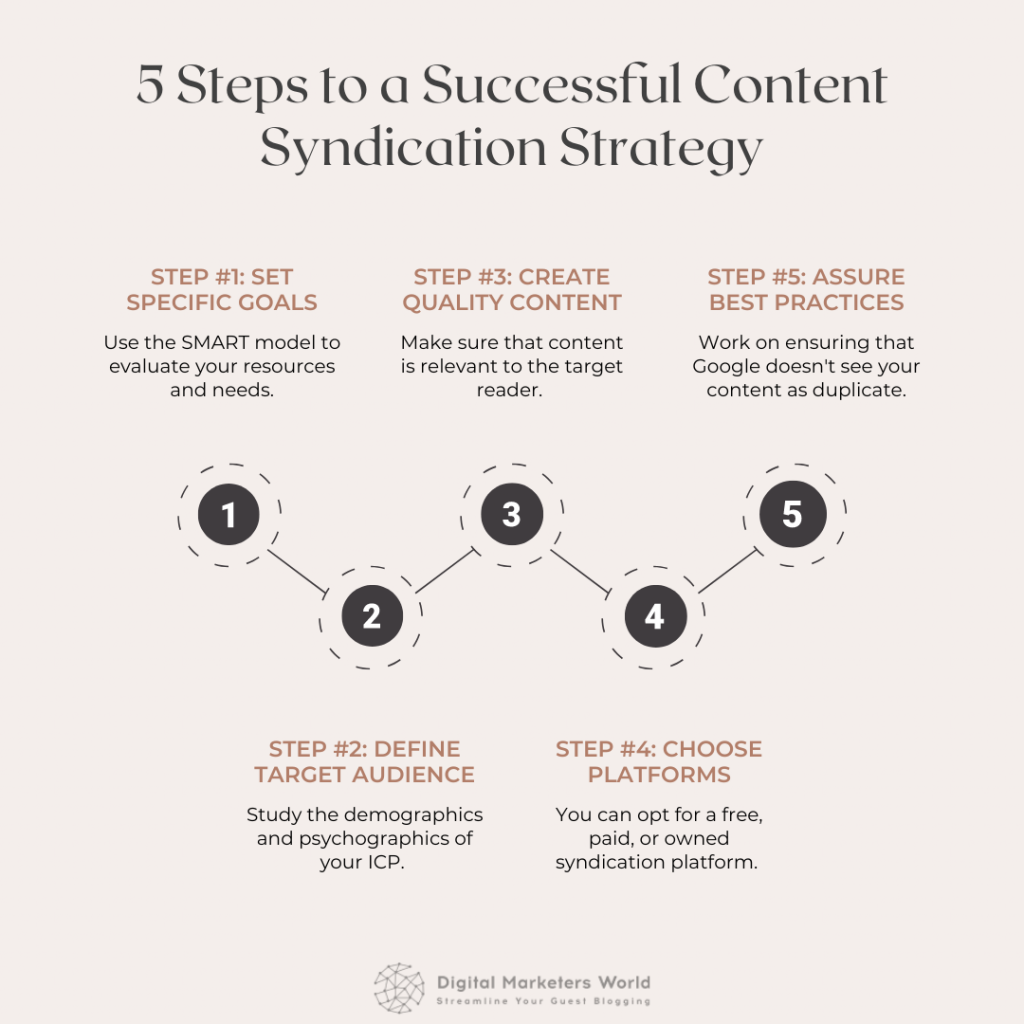
Now, let’s go over each step in this roadmap in more detail.
Step#1: Set your goals
Every content marketing strategy starts with defining your goals, and content syndication is no exception. We’ve already mentioned that you can syndicate blog content to generate leads, boost brand awareness, improve SEO (drive website traffic, get backlinks), and improve overall brand visibility.
However, before setting goals, you need to understand the resources available to you at a given moment. For this, we recommend the SMART goal-setting approach, within which you should evaluate your objectives based on the following criteria:
- Specific – define what you want to accomplish.
- Measurable – specify what metrics will be measured to understand whether your goal has been achieved or not.
- Achievable – analyze the resources available to you.
- Relevant – consider how this goal will align with the broader business objectives.
- Time-bound – think of a realistic time frame to achieve the goal.
Ultimately, this strategy won’t just help you define content syndication goals, it will also make them more tangible.
Step #2: Define your target audience
Much like with setting goals, you can’t move on with a content syndication strategy if you don’t know what group of people you want to reach. Your target audience is a person, or, in marketing terms, an ideal customer persona (ICP), who’s interested in your content and the offer it makes.
To understand, who your target audience is, you’ll need to define the ICP based on the following data points:
- Demographics – age, gender, language, location, education, job, income, marital status, etc.
- Psychographics – values, needs, goals, interests, obstacles, purchase behaviors, etc.
You can collect this data from various sources: your CRM, social media profiles, by surveying your existing customers, doing market research, and analyzing competitors. The more detailed the target audience description, the better you’ll understand what content to syndicate to attract it.
Step #3: Create quality content
High-quality content means a piece of information that offers real value to the target audience. So, you should use the best content available if you expect it to generate links, traffic, brand awareness, and leads, it should be unique.
So, besides syndicating blog posts, you can also republish:
- Infographics
- Case study
- eBook
- Swipe file
- Report
- Industry research
- Whitepapers
Such content has a higher degree of shareability, and its uniqueness bodes well for brand awareness. You can find more ideas of content for syndication in our article on lead magnets.
Step #4: Choose the right syndication platforms (and contact them if necessary)
As we’ve already figured, content syndication sites can be free, owned, and paid. On some of them, you can create an account and do everything yourself; with other platforms, you will have to contact them to see if they can host your content.
Apart from deciding on the types of content syndication platforms, you also need to consider other factors, such as:
- Marketing channels. If you’re choosing a paid platform, study its ways of content distribution and whether these marketing channels are used by your target audience.
- Target audience. Normally, the advice is to go for an audience bigger than yours. However, the platform’s readership should resemble the target audience you defined in the second step mentioned above. This is the only way to get more relevant leads.
- Spammy practices. If the platform is involved in some spammy marketing, promotion, or SEO practices, we recommend you avoid it.
The best option is to find a content syndication service through a recommendation from your peers. You can survey your connections on LinkedIn or ask a question on Quora or Reddit. People will share their experiences, helping you make the final decision.
Step #5: Assure best practices
One of the biggest challenges you need to watch out for with content syndication is about SEO. As we mentioned, you need to do everything to avoid creating a content duplicate or having spammy websites link back to your own blog. One of the tips we recommended is to use a noindex tag.
Another trick is to ask the platform to add the rel=canonical tag to the URL of the page where your content is syndicated. This tag tells search engines that they are crawling syndicated content, ensuring that it will not rank higher in Google search than the original. This is the safest way to avoid duplication.
Now, let’s see where you can republish your web content.
6 Content Syndication Websites to Get Started
To save you some time, we’ve done the research and picked six content syndication networks to get your strategy started. There are three free/owned resources and three paid websites.
Let’s see what they offer.
Free and owned syndication
Let us recap – free platforms imply building relationships with syndication partners before you can share your content on their websites. Owned platforms allow you to create an account and submit your content; there, you will also have to follow some community rules.
These three websites, in our opinion, are the best for free and owned content syndication:
- Medium: this is an online publishing platform that works in the genre of social journalism and includes both amateur and professional publications made by bloggers.
- LinkedIn: famous for being the most popular social network among B2B markets, LinkedIn also allows you to write and publish articles, which will be shown to your network and shared by LinkedIn users.
- Business2Community: this website is an independent online community distributing content and news about digital marketing, social media, PR, etc. It’s a perfect choice if you want to share some original research in the niches mentioned above.
By the way, you can also post original content on Medium and earn money from it. The platform has a partnership program, where the writers get paid based on how much of their content Medium readers check out. The more they read, the more money you’ll get.
Paid syndication
The platforms mentioned in the previous section definitely have their perks (organic traffic), but if you want more brand awareness and reach, you can consider paid syndication websites. Here are some of them:
- Taboola: it’s an advertising company providing “Around the Web” and “Recommended for You” boxes (aka chumbox ads) at the bottom of the pages with news articles. These boxes include sponsored links to the content owner’s website.
- Outbrain: this is a content recommendation platform that works the same way as Taboola – it displays content feeds and chumboxes with sponsored links to content. Outbrain operates on a PPC basis.
- Scoop.it: known for its content marketing software, this platform also syndicates content in exchange for payment.
Remember – these websites use the cost-per-click method to charge for their services, and the ultimate price will depend on your target audience, among other factors. That’s why it is crucial to have your ICP defined in detail.
Now, before we conclude our content syndication guide, let’s take a look at an example of this strategy in action.
A Content Syndication Example to Make Things Clear
To illustrate how brands republish their content to get more brand awareness and visibility, we’ve picked Venngage’s example.
Back in June 2016, the brand published a blog post on the Anatomy of a Killer Startup Name. The article also included an infographic showcasing the key components of a good name for a startup, along with some examples from major brands.
A little more than a week after the initial publication, the company syndicated the entire article on Medium:
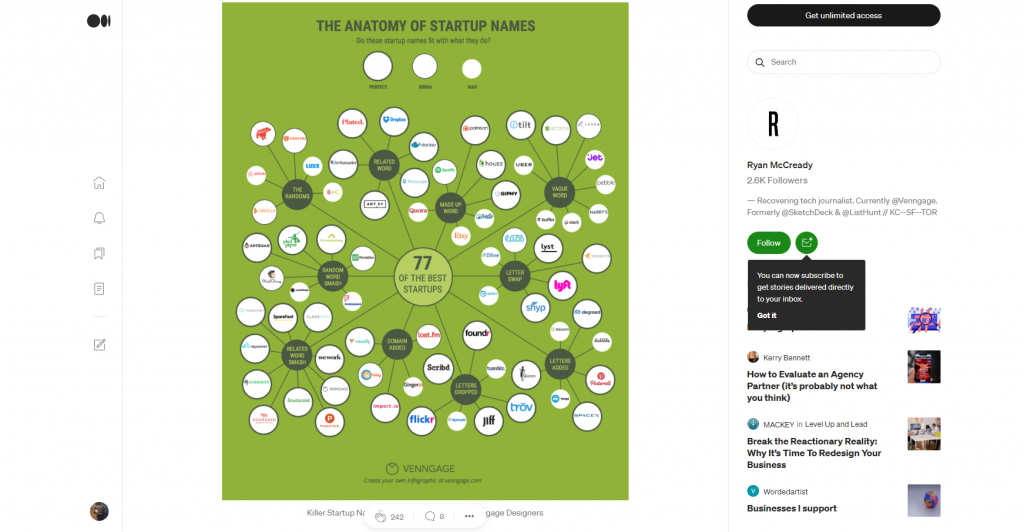
There is an attribution at the beginning saying that the article was published on Venngage’s blog, linking back to the original post and the content creator who authored it. Overall, the republished piece got 242 likes and eight comments on Medium. We can also assume that syndicating this post on Medium helped boost backlinks to the original page (the content was syndicated on the 5th of July:
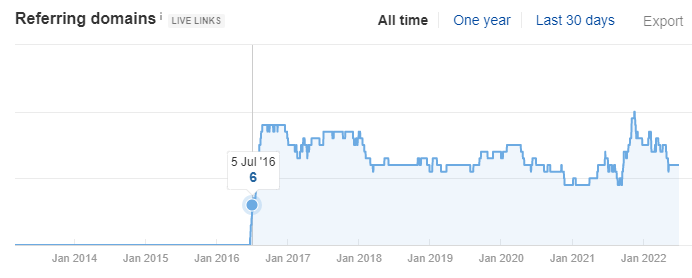
This is, of course, a stretch to assume that only syndicated content resulted in such a boost, but we can be confident that it partially contributed to it.
Now Over to You
So, let’s sum up everything we discussed in today’s guide:
- Content syndication is an outbound marketing strategy that implies republishing a piece of content on websites with a wider audience and reach.
- Content syndication can be free, paid, and owned.
- You can use this strategy to get more leads, brand awareness, referral traffic, and backlinks.
- You also need to be careful as, when done wrong, content syndication can result in low-quality leads, SEO problems, and harm your brand’s reputation.
Overall, we recommend content syndication to be used from time to time and only with content that brings high value. This way, you will get more relevant prospects and better quality backlinks.
Was this guide helpful? Check out more articles on digital marketing on our blog!

Mariia is a content strategist and editor at Digital Marketer’s World. She is passionate about educating others on all things marketing and believes in the power of the written word.
